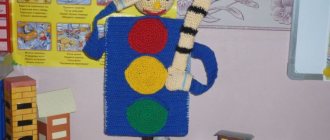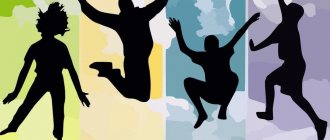How independence is formed and manifested in activities
Independent activity of children is a kind of autonomy. It is understood that the preschooler performs certain actions or solves practical problems without the participation of an adult.
From a theoretical point of view, independent activity requires setting a goal, choosing the means to achieve it, direct implementation, as well as at least minimal control.
Everything looks like a complex algorithm. But in practice it turns into a sequence accessible to the child. For example, looking at cubes or large parts of a construction set, the baby begins to build a tower, similar to the one he built yesterday with his dad. All components of the activity process are present here, but the preschool child himself conceives and implements the idea.
The manifestation of independence does not happen suddenly and instantly. At about 3 years old, the child begins to assert his independence at the everyday level. At first he performs the actions with the help of an adult, but the next step quickly comes when the baby wants to free himself from this help. Every now and then the persistent “I myself!” sounds.
The adult gives the child a model of how to perform the action. Imitation is a child’s primary activity. The preschooler takes independent actions on his own initiative, and he still needs to mature for them.
We can distinguish the stages of development of independent actions, which can be traced in any type of activity that the baby undertakes:
- Joint-shared attempts. They start an activity (drawing, storytelling, any practical activity) together. Then the adult actively helps the child, or even does the main part.
- Performed by a preschooler, but with hints and based on the demonstration of the necessary actions by the mentor.
- The adult proposes, that is, sets a task, and the child copes with it. This stage can be called performing.
- The preschooler himself takes the initiative and performs actions in order to achieve the goal that he sets for himself.
In childhood, the boundaries within which children try their hand are expanding every day. The preschooler begins to show independence in any activity available to him: cognitive, playful, creative, productive.
Independent creative activity
Independence in creative activity develops gradually both in simple exercises and when the child becomes involved in artistic activities. At first, careful intervention from an adult is necessary to help with specific operations.
The youngest preschooler is just beginning to master the tools necessary for creativity. Holds a pencil confidently, but draws mostly chaotic lines. Already making some constructions, but only the simplest ones.
The field for the manifestation of creative independence in early preschool age is still gaining diversity. It is presented:
- Drawing
- Making mosaic pictures
- Construction from large parts
At 3-4 years of age there is already interest in independent creative activities. It seems that the baby is engrossed in rolling the car while the mother is putting together a mosaic figure and unsuccessfully trying to get the child interested in this activity. And after some time, the baby himself, albeit chaotically, connects the elements of the mosaic or builds a bridge according to the model. Some children will agree to little help. Others will only accept the suggested name.
In middle preschool age, interest in the musical field intensifies. If earlier children pressed the keys of children's musical instruments and rejoiced at the sound they produced, then by the age of five they are interested in chords. Preschoolers pick up the melody by pressing 2-3 keys in a row and begin to experiment with sounds.
Five-year-old children discover word creation. This is an important stage of speech development - the grammatical structure of speech is formed. What words do children come up with! Moreover, they do this not at the behest of an adult. It's time to encourage your child to write his own stories. An adult can offer a preschooler a series of pictures and ask them to tell a story.
Independent creativity of older preschoolers
Older preschoolers do not need such support for their artistic or design experiments. They prefer to hear feedback only about the result. They plan, select funds, and also carry out their plans without outside help.
Of course, children eventually expect to hear praise. At the very least, support, but not criticism. If a child diligently created his drawing or appliqué, then he wants to receive a positive assessment, and not a remark that not everything was successful.
Negative assessments suppress the need for independent activity of this type. Drawings are not praised - the preschooler loses the desire to draw. If they don’t admire the craft, the child’s interest will fade as well.
The preschooler’s motivation for independent action will not disappear; it will manifest itself in other areas. However, it is important for adults to take into account that creativity should not be taken risks and that it is worth supporting the preschooler.
A fairly high level of speech development in older preschoolers opens up primary literary creativity for them. They make up their own stories and rhyme words. Such exercises are characterized by a high degree of independence. If an adult asks a 5-6 year old child to compose a fairy tale, he will most likely refuse. It’s another matter if this impulse comes from within, and the preschooler himself decided to come up with an amusing story.
The goals of writing can be different - to fantasize about what you want, to repeat a memorable plot with a focus on your life, to make your loved ones or friends laugh. In any case, such creativity perfectly develops speech and imagination, and also forms creative initiative.



